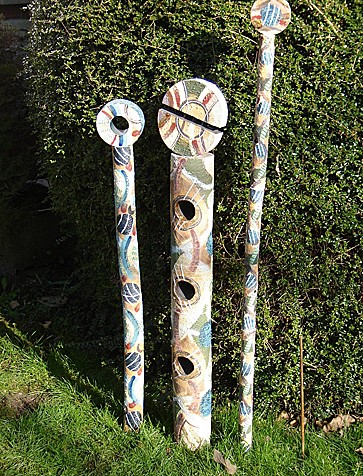Diana Barraclough
Her studio is in the basement of her house; much warmer than the draughty stable she started in many years ago.
Whilst studying ceramics at Bournemouth and Poole College of Art under David Ballantyne, she won a travelling scholarship to Sweden and also worked with David Leach in Devon. After qualifying, she worked for Mary Rich in Cornwall, gaining valuable experience in running a work-shop before setting up her own studio in Berkshire. This was a time of growing demand for handmade, domestic pots and for many years she did a great deal of repetitive throwing, selling mainly to craft shops and galleries in the South of England.
In the 1980s she returned to making the individual ceramic tiles that she has loved so much at college and also completed more than 50 commissions for tile murals set in kitchens and bathrooms. All the tiles are hand rolled and decorated using relief, stains and glazes to depict gar-dens, woods and English wildlife.
She works mainly in stoneware, firing the kiln with pro-pane gas in a reducing atmosphere - which means restricting the amount of oxygen in the kiln. She uses a hand building body which is very strong, stays flat and seldom cracks. To add texture and contrast and give the surface a 'paintily' feel, she add slips, grog and sand. She also adds pieces of clay, rolled and cut up into leaves or waves for example which are applied to the unfired piece.
Cornwall supplies not only driftwood but much of her inspiration. The coast and its sea birds, the lush sub-tropical gardens and the strange ancient landscape of Penwith with its field systems and standing stones and sense of mystery, are all themes that occur constantly in my work, which tends to be colourful, but she also enjoy working with a neutral palette.
Now her work has moved further towards garden sculpture. Ceramic totems inspired by two visits to Canada and Gaudi's extravagant work in Barcelona have always fascinated her. They appear in many cultures, but especially amongst the American Indians. Some totems depict clan legends, others honour the dead or describe a way of life, with revered animals both hunted and worshipped.
Her totems are thrown in pieces (typically 5 or 6), turned and then joined to allow her to decorate the whole piece as one, using layered clays, coloured stains and applied relief. The decorated piece is then split back into 2 or 3 pieces for biscuit firing after which glazes are applied. The final stoneware firing is to ~1280oC.
Recently I have found the designs for the totems and tiles .Totems tell tall stories based on nature and the environment. They are colourful and are designed to withstand the elements. Tin was once one of the main industries of Cornwall and the remains can still be seen all over the county, especially around the Penwith area. These pieces are in-spired by that area with its heather covered hills and sea under which the Geever Mine runs.
Next artist


